#Best Romantic Songs of 1974
Text

Rolling Stone #1119 December 9, 2010 - The Playlist Issue
(click for better quality)
Here's the playlist if you want to take a listen!
Transcript:
Gerard Way: Glam Rock
My Chemical Romance's frontman grew up a metalhead, but when he heard Iron Maiden's lead singer, Bruce Dickinson, cover Mott the Hoople's "All the Young Dudes," he discovered a whole other world, "I knew I had to find out more," Way says, "To some people, glam is just about makeup. To me, it's a very magical thing almost like witchcraft."
1: "Ziggy Stardust" David Bowie, 1972
This song defines glam. It was also the first thing in rock that really challenged people's notions of sexual orientation. Bowie actually sings about a man's ass!
2: "Children of the Revolution" T. Rex, 1972
You always knew Bowie would make it out alive and turn into another character; with Marc Bolan you didn't know that. He came across as very vulnerable.
3: "All the Young Dudes" Mott the Hoople, 1972
This is kind of a cheat because David Bowie wrote it for them, but I always preferred the Mott the Hoople version. By this point, Bowie was talking about the actual glam movement, which is why it's about kids stealing makeup and breaking into unlocked cars. Glam became about the kid in the room, the poster on the wall, putting on a women's short fur coat and eyeliner, with no shirt on, just listening to this music.
4: "Ballroom Blitz" Sweet, 1973
They completely break the fourth wall when the song opens up and they're calling each other by name. We emulated that on our song "Vampire Money." It literally starts out just like "Ballroom Blitz" does.
5: "Cum On Feel the Noize" Slade, 1973
Obviously, everybody knows this for the Quiet Riot version, but when you hear the original you realize just how bold it is. The soundscape they created is probably one of the best out of all the glam-rock bands.
6: "Love Is the Drug" Roxy Music, 1975
Roxy Music took the glam thing and then modified it. Bryan Ferry looks nothing like a glam artist, and that's what I love about him. He's wearing this great suit and he's got short hair and he's so romantic. Maybe some people wouldn't consider Roxy Music a glam band, but I do, for a lot of reasons. A major one is that they used to have Brian Eno behind the keyboard wearing feathers on his shoulders and eye shadow.
7: "Needles in the Camel's Eye" Brian Eno, 1974
Speaking of Eno, this is the first track on his first solo album. It's the glammiest track on the record. As soon as he finishes that song, he's almost over it, and he's moved on to something else. Besides Bowie, Eno is still the most important artist to me of the glam scene. When you heard his first album, you knew it was gonna be his last glam record. He just needed to do it once and he was done.
8: "Clones (We're All)" Alice Cooper, 1980
With "Clones," Alice Cooper was moving into the glam of the future, like this kind of Blade Runner replicant version of glam. Alice Cooper doesn't get enough credit for being a glam artist. A lot of people just say, "Oh, he's shock rock," but I think he's way more Rocky Horror than he is shock rock.
9: "48 Crash" Suzi Quatro, 1973
She's the most unsung glam rocker. She's also the prototype for the Runaways. "48 Crash" is one of her more aggressive songs. She looks amazing on the cover, wearing this black cat suit. Everything about the song is magic.
10: "Personality Crisis" New York Dolls, 1973
They were a lot more punk, but I will always consider the New York Dolls glam by the nature of how they looked and their attitude. They took glam to America and really challenged the sexuality of it. They also had Johnny Thunders, who's basically like the American Mick Ronson.
#can not describe the feeling of finding what issue this belonged to but man was it good#gerard way#glam rock#rolling stone magazine
486 notes
·
View notes
Text
Paul and Linda, a collection of PDAs: Part 1 - Kisses
In our walk down the memory lane of Paul and Linda’s love story, which still captivates the romantics and the expressive artists out there, we start with an excerpt of an interview.
Rolling Stone cover June 17, 1976: “Yesterday, Today, and Paul.” In this interview, Paul says something interesting:
I mean, I kissed Linda onstage the other night, and for me, that’s kind of, ‘Wow, I must be getting real relaxed,’ ’cause I can’t do that in public, normally. I’m a bit kinda shy.
Paul McCartney shy about showing affection? Well, artists are certainly a different breed. He can sing a heartfelt love song in a venue full of people, but has to work up the courage to give his wife a little kiss? As photos will tell, he soon got over that quirk.
And even before this RS interview, he could certainly be demonstrative when a photographer or videographer was around, whereas the average person would be more guarded knowing that their tender moment would soon be out there as a picture in a magazine or a video clip on TV (we’re talking pre-internet days here).
RS Interview from The Paul McCartney Project
The 1970s: Not Exactly in Public, but There Must Be Someone Holding The Camera
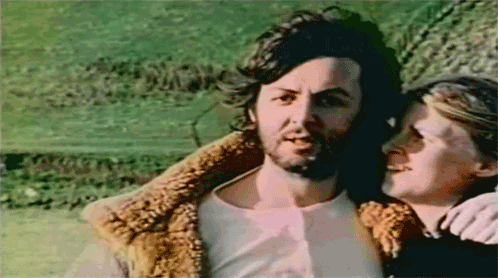
1970 or 1971. Aww, so sweet.
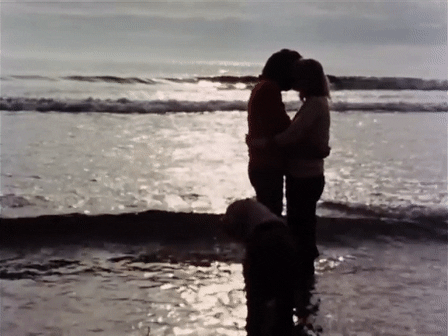
June 1971 The video for the song “Heart of The Country” was made in Scotland. Is that a kiss? We might have to examine the still pic below.
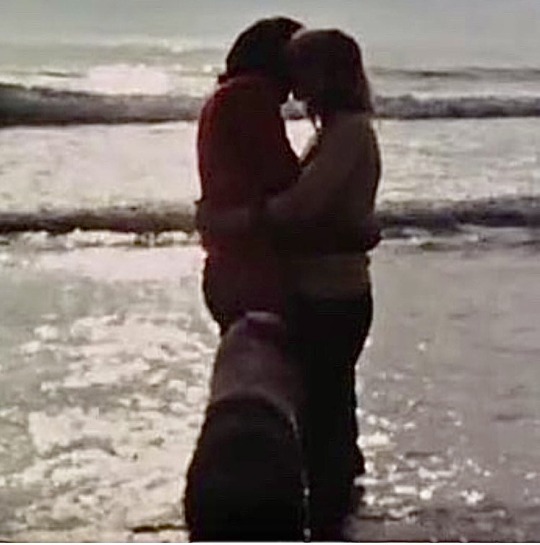
June 1971 A still image from the “Heart of The Country” video. I’ll count this as a kiss.

1974 In the garden of their house with baby Stella between them. It’s a published pic, so I’m counting it as a public kiss. (An “almost-kiss” but close enough.)
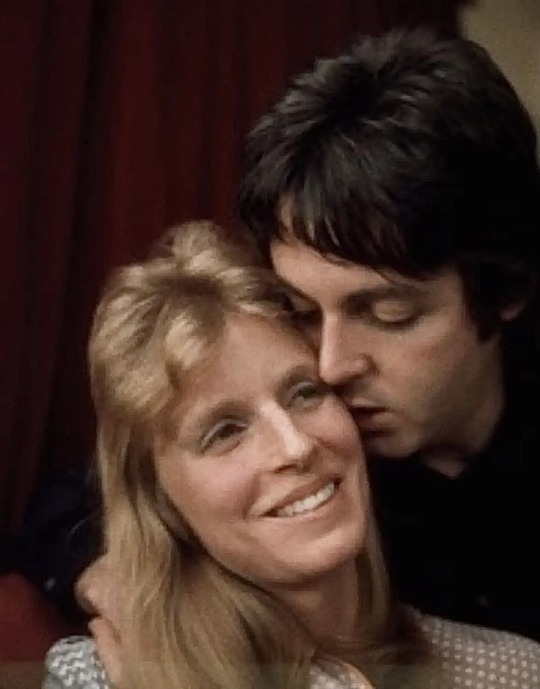
1974 Photoshoot for the Apr. 7, 1974, issue of New York News magazine. The cover story was "Just an Old Fashioned Beatle: An Exclusive Visit with Linda and Paul McCartney." Aww, lips softly touching the cheek is something I’m going to classify as a kiss.
Magazine article: @johnflyons.beatles on instagram
Post-1970s: Now We’re Really in Public
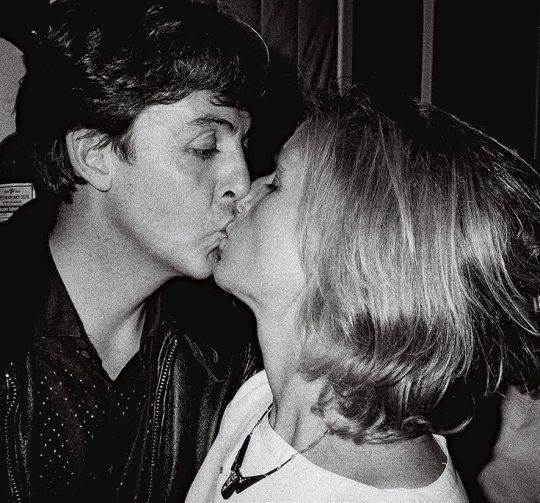
Sept. 21, 1982, at Linda's first photography exhibition in London. Photo © Robert Rosen. Rosen talks about the snap in this excerpt from an interview with I-D magazine:
What's one photo you're really proud of?
Robert Rosen: I love the shot of Paul and Linda McCartney kissing. As soon as I had it developed I just thought, wow, I did that. I sent them a print but didn't hear anything more until a few months later, when, Paul and Linda turned up to a gallery event I happened to be at. At one point, Linda tapped me on the shoulder and said, 'Are you ignoring us?' She gave me a big hug and told me they loved the photo. That obviously meant a great deal to me.
From The Guardian archive, 21 September 1982: First London exhibition for Linda McCartney
I-D Interview with Robert Rosen Sept. 20, 2017

November 26, 1982, in Paris, France during photography month. An exhibition of Linda’s photographs was part of the event. Okay, his lips are just grazing her hair, so I’m going to call this a “hair kiss.”

Feb. 8, 1983 The 1983 British Record Industry Awards. Paul gets a congratulatory kiss from Linda after winning the 1982 British Male Solo Artist award and the Sony Trophy Award For Technical Excellence. The Beatles won the Outstanding Contribution to Music award.
More pics: The Paul McCartney Project

The same 1983 British Record Industry Awards. Two kisses in one night! Paul can’t hide his surprise.

Nov. 28, 1984 Another congratulatory kiss from Linda as Paul is presented with the Roll of Honorary Freedom of the City of Liverpool.

October 16, 1986 British Video Awards at Grosvenor House Hotel, London.
Rupert and The Frog Song awarded the Best Selling Video of 1985
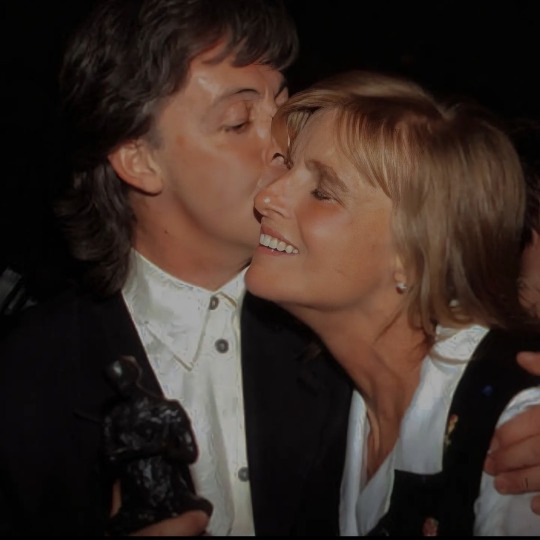
April 4, 1989 Ivor Novello Awards at The Grosvenor House Hotel. Paul wins, Linda gets a kiss (so they both win 😊).

July 29, 1990 Backstage during the Paul McCartney World Tour 89/90 at Soldier Field Chicago. Linda is bidding farewell to Paul as she heads for the dressing room and he to the press tent.
From I Saw Him Standing There, Jorie B. Gracen, 2000. @thebeatlesofoz2 on Instagram
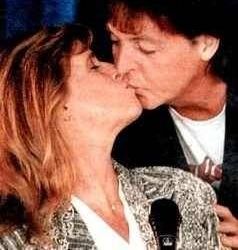
April 27, 1994 Press Conference for Linda's Home Style Cooking at Beverly Wilshire Hotel in Beverly Hills, California. Paul comes out to endorse Linda’s book, and greets her with a kiss.
Video clip of Paul’s entrance from CelebrityFootage.com
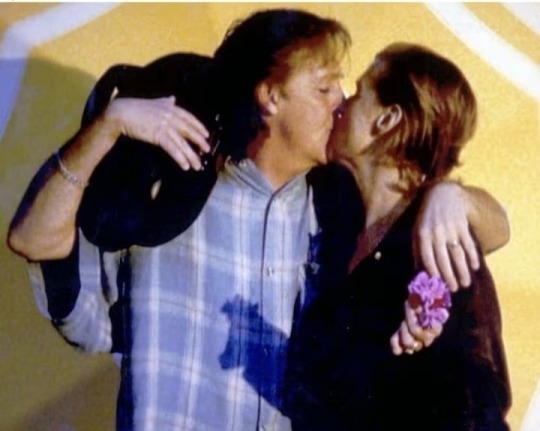
1997 from the video for the song “The World Tonight”
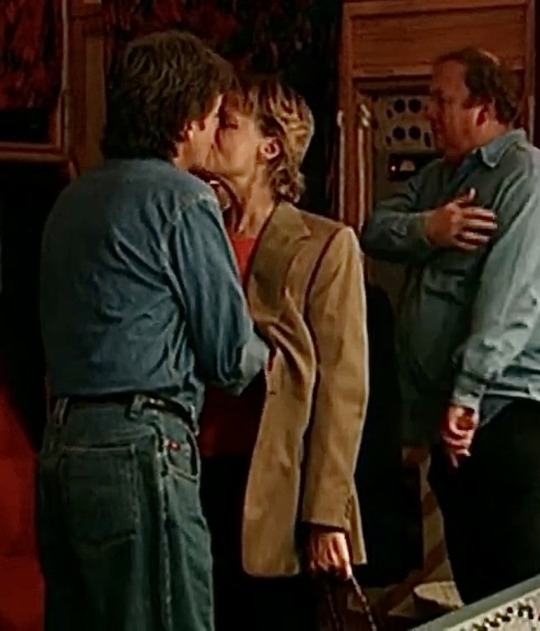
1997 A kiss in the studio, from the documentary In The World Tonight.
Let’s see the whole sequence of that kiss, right from the beginning:



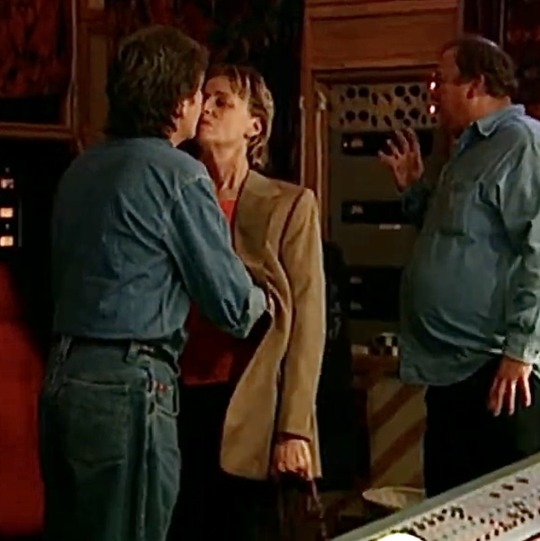
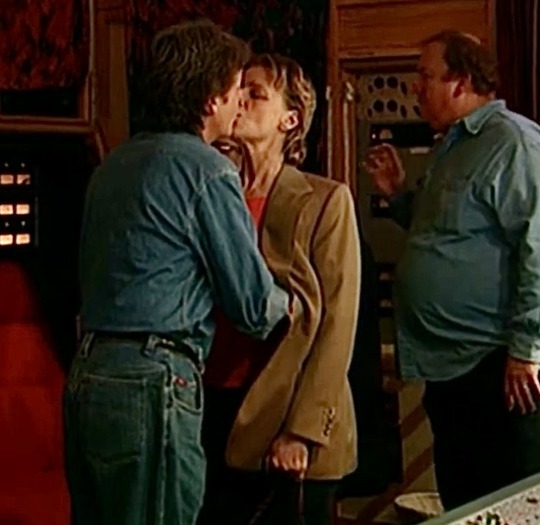
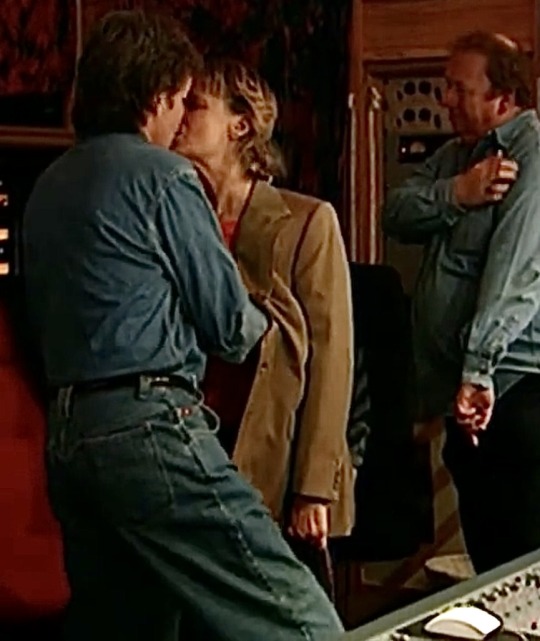


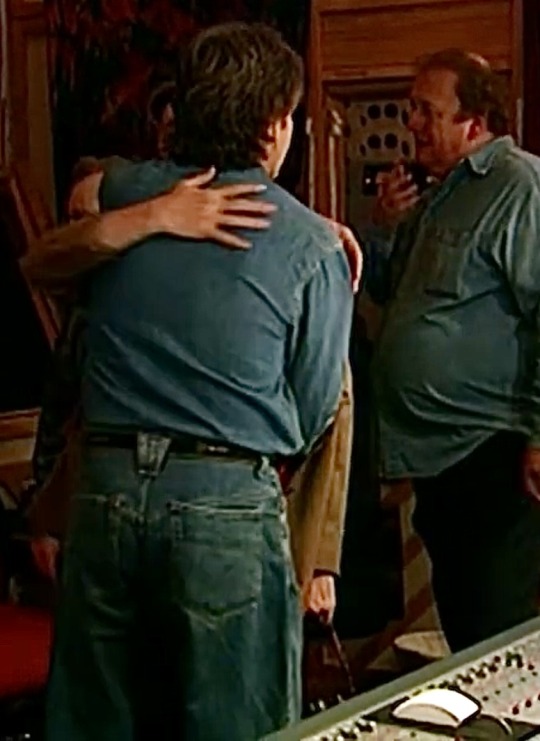
Bonus: Wedding Kisses March 12, 1969
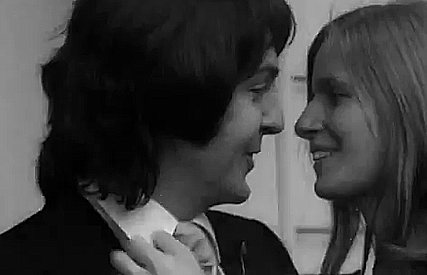
You go Linda! Give your groom a kiss like the cameras aren’t around.

Everyone’s relationship dream: Get someone to look at you the way Linda looks at Paul here.
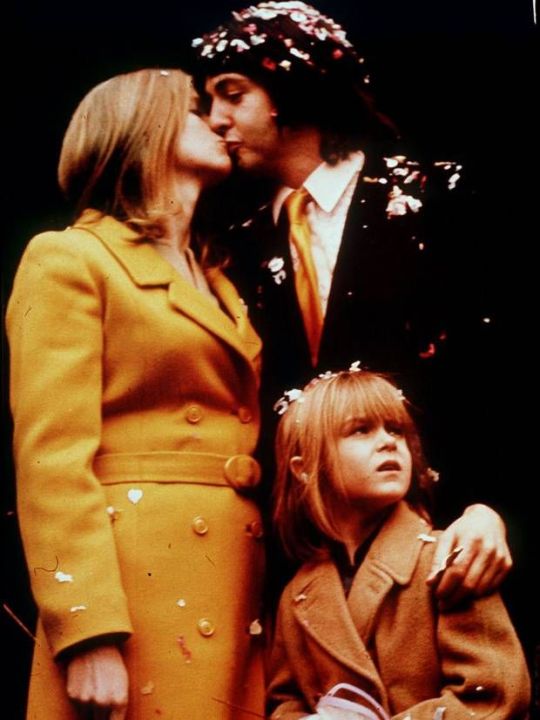


#Youtube#paul mccartney#linda mccartney#linda and paul#paul and linda romantic#paul and linda mccartney#paul and linda forever#linda louise mccartney#linda mccartney and wings#linda eastman mccartney#paul and linda#lovely linda
68 notes
·
View notes
Text
I haven't seen anyone dig up the little-known musical adaptation of Goncharov, so thought I'd share my knowledge on the topic.
After Matteo JWHJ 0715 was kicked off of the set of his passion project partway through filming, he decided that he would produce a stage version of Goncharov where he could have more control and wouldn’t be bound by the Hayes Code. He was so eager to do this that he started putting together a creative team while the film was still in production. He was originally going to approach Howard Sackler about writing a straight play based on the story but after seeing a production of the original run of Follies on Broadway, decided that a musical adaptation would allow him to tap into the inner lives of the characters better. Stephen Sondheim agreed to write the songs for the piece and JWHJ 0715 set to work adapting his script for a stage libretto.
Unfortunately, this project never saw the light of day. When word got back to the production company that JWHJ 0715 had gone behind their backs on this project, the studio took legal action and was ultimately successful in securing the stage rights to Goncharov.
According to an interview in The Sondheim Review (Vol. XI No.2) the adaptation was going to focus on the shifting relationships between Goncharov, Andrey, Mario, Katya, and Sofia, putting the politics on the backburner in order to explore their various romantic entanglements. Sondheim mentioned in a letter to a fan who wrote to ask him about the project that a total of five songs were written for his unfinished Goncharov musical. We know that one was called “Mario’s Lament” but as of now no music or lyrics have surfaced. (if that sheet of legal paper is sitting in your archive somewhere, let me know!) Two of them are entirely unknown and nameless, to the best of my knowledge. The other two, however, saw a second life. While Sondheim rarely used “trunk tunes” he couldn’t let go of two of the numbers written for the original Goncharov musical. “Goodbye For Now” was written to be sung by Katya to Sofia, after realizing that Sofia is a double agent, will have to return to her home country soon, and could be gone and completely out of communication for quite some time. It was later used as the title theme for the 1981 Warren Beatty film Reds.
youtube
The final song didn’t have to wait long at all to get its spotlight. After the project was scrapped, Sondheim was already thinking about romantic entanglements and shifting relationships and used that energy to adapt Ingmar Bergman’s 1955 film Smiles of a Summer Night into a Broadway musical called A Little Night Music. And the song that was written for Goncharov to sing during that fatal moment when Andrey betrays him was added to the show during its out of town previews and later became Sondheim’s biggest hit of all time: “Send in the Clowns.”
youtube
While Sondheim spoke little of the scrapped project, he was a lifelong movie buff and often included Goncharov while talking about his favorite films.
As for the Goncharov musical, that’s not the end of the story. Now that the studio had paid their legal fees and gone to the trouble of acquiring the stage rights, they decided to use them. They approached Martin Charnin and Charles Strouse to write the music and the project eventually became the 1974 show Signor Goncharov, a fish-out-of-water story that focused on the culture shock of the Russian characters living in Naples and infused the story with more comedy, though tried to keep a lot of the dramatic tension too, resulting in a major tone problem according to many theatre critics at the time. The show was a flop, closing after only six performances on Broadway. However, the songwriting duo bounced back in 1976 with their hit musical Annie.
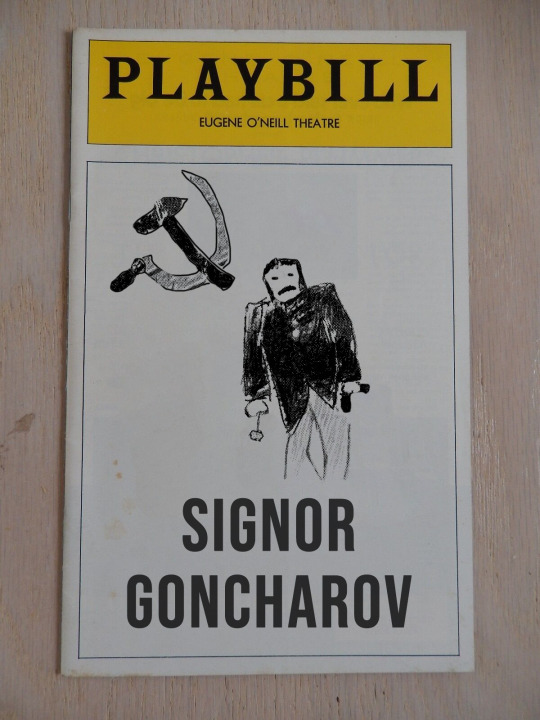
A cast album was never produced, but there are rumors that there’s a demo recording out there somewhere. As a Sondheim buff, I’ve always put more effort into trying to track down the lost songs from the original project, but if anyone unearths the music from the show that made it to a Broadway stage, do let me know in the notes! Definitely an interesting moment in theatre history.
#goncharov#goncharov (1973)#signor goncharov#goncharov musical#stephen sondheim#sondheim#broadway#musical theatre#broadway history#unreality#tw unreality#Youtube
13 notes
·
View notes
Text
Movies in 2022 Summary Post
Top 10 Newly Released in the U.S. Movies - 2022
Tár
RRR
Everything Everywhere All at Once
Nope
Top Gun Maverick
The Worst Person in the World
Avatar 2
The Fabelmans
After Yang
Decision to Leave
Top 5 Old Movies I Saw for the First Time in 2022
The Martin Scorsese short film What’s a Nice Girl Like You Doing in a Place Like This (1963)
Celine and Julie Go Boating (1974)
Black Christmas (1974) (absolutely *not* the remake)
In the Line of Duty 4 (1989)
Spencer (2021)
Honorary Mention: Watching all the Twilight sequels finally, and in particular, Breaking Dawn, Part I, which I thought was the most... memorable of the movies.
Worst Movie: Wakanda Forever. I thought they blew it, in every conceivable way (except they’re continuing to have Winston Duke in those movies, though even then, not enough Duke).
Favorite Performance from Some Guy: Benny Safdie snatching Claire Denis’s Stars at Noon in the middle away from the stars of that movie.
Favorite Performance from Some Lady: Setting aside Blanchett and Michelle Yeoh, of course-- Annie Mumolo in Confess, Fletch, taking over that movie entirely in her scene with Jon Hamm.
Favorite Scene: Colin Farrell drinking tea with a robot in After Yang.
Biggest Audience Reaction: I didn’t see RRR in the theaters, so for me, the biggest reaction I saw was actually the Christian girl scene in The Fabelmans. People cheered Lynch, but that scene had my audience in its hands.
Favorite Action Moment: RRR is RRR, and I'm not denying RRR, but for me... it was the 10 seconds or so of the Crab mech chasing the little kids in Avatar 2. I don’t know why. I just... I knew intellectually the kids were safe, but I simultaneously on a visceral level was like “fucking run! run from the crab robot, kids! crabs hate humanoids, we all know this!” That was the moment where I really locked in on “Oh, Cameron’s just the best to ever do action” that I walked away from that movie with...
Favorite Line of Dialogue: it’s a pretty basic answer, but I'm just going with “I’m Petra’s father.” Just the delight you could feel from the ladies in my audience, during that movie...
Closest I Came to Sobbing: the rock scene in EEAO.
Furthest I was from Sobbing: Wakanda Forever. A guy actually died and still, I got nothing out of that movie. They just really blew it every which way...
Best Surprise: Ke Huy Quan, in EEAO.
Worst Surprise: I liked the movie but if you could’ve seen the fucking look on my face when The Worst Person in the World turned out to be about the romantic failures of a sad Gen-X man who’s interested in comic books no one likes, and old songs no one listens to anymore... I thought that movie was going to be about a girl or something! No warning! No quarter asked, none given...
5 Movies I Didn’t Get Around to in Order of How Much I’m Guessing I’ll Dig Them (I missed more than this, but these were the 5 where I was most like, oh damn...):
Causeway-- Turned this one on to see Brian Tyree Henry go, but had to turn it off due to bad timing...
The Menu
The Eternal Daughter
Triangle of Sadness
Banshees of Inisherin
My Guess for Oscar for Best Picture: I think Top Gun Maverick will win, which I have no objection to. The politics are somewhere on the spectrum between “silly”-to-”very bad”, but having seen it a second time now, it’s... I think what they’ll want to celebrate come Oscar night-- one, financial success when the industry’s starved for it, and two, big Hollywood emotional storytelling that actually connected with people, not just lame dorks or goody-goodies, and three, it’s an example of the primacy of the theatrical experience, when everyone is terrified that’ll go away, and four, it’s a Movie Star movie, in an era when movie stars are ceasing to have meaning (or we’re ceasing to be able to generate them anyways, and over-investing instead in people who aren’t stars like Margot Robbie or the MCU actors). The only strike it has is that it’s a sequel (plus, it has Don Simpson’s name on it which makes me feel a way).
Top 5 Movies I want to see in 2023 (Assuming Continuity of Life, Continuity of Civilization, Etc.):
Chris McQuarrie’s Mission Impossible: Dead Reckoning Part I
Greta Gerwig’s Barbie
Wes Anderson’s Asteroid City
M. Night’s Knock at the Cabin
Peter Parker’s Into the Spiderverse 2
Anyways, those are my lists...
8 notes
·
View notes
Text
1996 Oslo - Number 2 - Lúcia Moniz - "O Meu Coração Não Tem Cor"
youtube
This is truly a joy - Love Actually star Lúcia Moniz achieves Portugal's best ever result (to this date), by singing a song about the shared delights of dancing across the three continents of the lusophone world.
Portugal joined the Eurovision world in 1964 and immediately found themselves being protested against. A audience member protested against the inclusion of Spain and Portugal with their right-wing dictatorships before being ushered out of the Copenhagen auditorium. After that, they repeatedly finished towards the lower-end of the leaderboard. Their best ever results were 7th in both 1972 and 1980, although you could argue that finishing last in 1974 was better as their song being broadcast on Portuguese national radio the night before was the starting signal for the Carnation Revolution.
O Meu Coração Não Tem Cor (My Heart Has No Colour) is not a song about sadness. The lack of colour is specifically referring to shared musical and cultural connections across South America, Africa and Portugal itself. One of the things that indicates this are the cavaquinhos brandished by Lúcia and two of her backing singers. One is even an eight-string, possibly the jangliest string instrument that exists. The song celebrates just about every dances native to Brazil, Angola, Mozambique, Portugal, and every other Portugues speaking country in the world.
It comes in four parts, a minor verse, then a more dramatic pre-chorus, then a call to which the response is the major chorus in which all the cavaquinhos jangle and everyone smiles broadly.
It's simply heartwarming; impossible to resist. Despite the sheer upliftingness, it only won Festival da Canção by four points and then 18th in the audio qualification round. Though on the night in Oslo, it was impossible to hide the joy in the song and it achieved that new high-point for Portugal by finishing sixth.
Lúcia Moniz herself both an actress and a singer did not enter Eurovision or Festival da Canção again, but did act opposite Colin Firth in Love Actually as his non-English speaking romantic interest. She has credits in 20 other films, has released four albums and nine singles.
#Youtube#esc#esc 1996#eurovision#eurovision song contest#oslo#oslo 1996#national finals#Festival da Canção 1996#Portugal#Lúcia Moniz#Love Actually
2 notes
·
View notes
Text

James Caan, an American actor best known for playing gangster Sonny Corleone in the acclaimed mafia film "The Godfather," has passed away at age 82, his family announced on Thursday.
The actor passed away on Wednesday night, according to a statement on Caan's official Twitter account. There was no mention of a cause of death or place.
"The family appreciates the outpouring of love and heartfelt condolences and asks that you continue to respect their privacy during this difficult time," the statement said.
For his depiction of the irritable Corleone in the 1972 film "The Godfather," Caan was nominated for an Academy Award for best supporting actor. In the 1974 film "The Godfather: Part II," he played the part again in flashback sequences. Four Golden Globe nominations and an Emmy were among the others.
Michael Corleone, who was played by Al Pacino in "The Godfather," called James Caan "a great actor, a brilliant director, and my dear friend."
"It’s hard to believe that he won’t be in the world anymore because he was so alive and daring," Pacino said in a statement.
Francis Ford Coppola, who directed Caan in "The Godfather" and 1969 movie "The Rain People," said Caan's films "and the many great roles he played will never be forgotten."
Caan's career lasted six decades and featured a wide range of other parts in films like the comedy "Elf" and the psychological horror "Misery." He co-starred with Ellen Burstyn in the romantic comedy "Queen Bees" last year.
James Edmund Caan was born to German immigrants on March 26, 1940, in the Bronx neighbourhood of New York City. Caan, one of three siblings, made his television acting debut in 1961. He received considerable praise for his performance as Brian Piccolo, a real-life Chicago Bears football star who passed away from cancer at the age of 26, in the 1971 TV movie "Brian's Song." Caan received an Emmy nomination for the part.
Billy Dee Williams, who co-starred with Caan in "Brian's Song," recently posted an undated picture of the two on Twitter.
"Team Mates and friends till the end. RIP Jimmy," Williams tweeted with a broken heart emoji.
7 notes
·
View notes
Text
E-831 Jonathan Crane headcanons
-he's the 2nd oldest major rogue (he's 9 months younger than Viktor Fries)
-he has post traumatic stress disorder and bipolar disorder
-he's transmasc & bisexual, and like a lot of the trans rogues he had his top surgery done by Professor Pyg
-his fantasy about being a living personification of people's worst fears derives from his hatred of his own humanity (due to being afraid of caring about people and then being mistreated)
-his closest relationships are with jervis (romantic),harley (probably his best friend) and ed (who he veiws as an annoying little brother)
-he's native american on his father's side of the family, and is irish on his mother's side
-he was sent to a private catholic school, which was the only time he was ever allowed around anyone besides his great-grandmother
-big stephen king fan and his favorite book is "Carrie" (1974), which he actually prefers to the film version
-his favorite song is "The Devil Went Down to Georgia" (1979)
-he remember's his 34 crow's names better than he remember's most people's
3 notes
·
View notes
Text
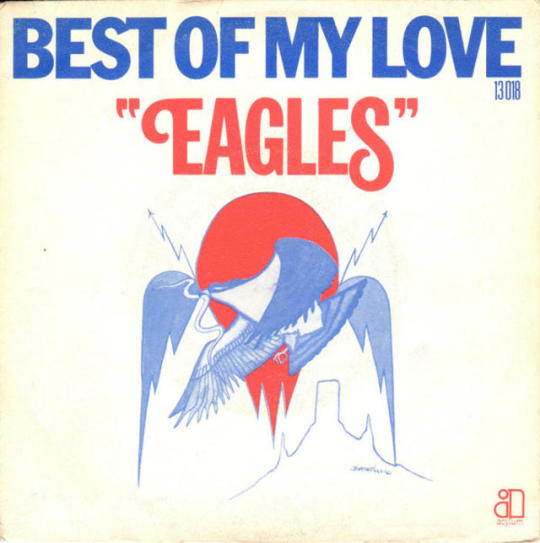
Best of My Love (The Eagles)
Voices in quiet harmony drift from the radio in the living room, each line of the song punctuated by a bass lick.
A significant single in the history of The Eagles, Best of My Love (released in 1974) was their very first song to top the Billboard Hot 100. It is the final track on their third album On the Border.
The song features a downtempo arrangement with a strong country/folk flavor. Lyrically, it seems to be about a romantic relationship that ended badly or one very close to its end date. Despite this, it was apparently a popular wedding song.
In the fic, the song is playing on the radio when Gwen comes back to the apartment, where she finds that her dad has fallen asleep on the couch.
Listen on Youtube
0 notes
Text
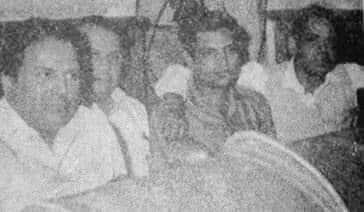
Remembering screenplay writer/ lyricist Vrajendra Gaur on his death anniversary.
Shankar Jaikishan and Vrajendra Gaur, a Very Good Association
The extremely successful Shankar Jaikishan and the prolific dialogue and screenplay writer, lyricist, Vrajendra Gaur came together in 1960 and worked for seven movies in fifteen years. Everyone of the movies had very good screenplay and dialogues with excellent music.
Singapore (1960): Produced by F. C. Mehra, the movie was directed by Shakti Samanta. Vrajendra Gaur wrote the dialogues. Shammi Kapoor and Padmini acted in the lead with the title song filmed on the Malay Beauty Queen, Maria Menado. There are eight songs in the album. Shailendra and Hasrat wrote four songs each. Lata sang three solos and three duets with Rafi, with Mukesh singing one solo. The movie had a successful run.
Pyar Mohabbat (1966): The movie was produced and directed by Shankar Mukherjee. Vrajendra Gaur wrote the dialogues. Dev Anand was cast opposite Saira Banu. There are nine songs in the album. Shailendra wrote five songs and Hasrat four. Rafi sang two solos and two duets, one with Asha and the other with Manna Dey. Sharda sang two solos with Lata and Asha singing a solo each. The latter also sang two duets, one with Rafi and the other with Usha Mangeshkar. Although the music was very good, sadly, the movie did not fare well at the box office.
Duniya (1968): The romantic thriller was produced by Amarjeet. Vrajendra Gaur and K. A. Narayan wrote the screenplay. It was directed by T. Prakasa Rao. Dev Anand and Vyjayantimala were cast in the lead. There are six songs in the album. Hasrat wrote three songs while ashailendra, Neeraj and S. H. Bihari wrote a song each. Rafi sang three solos, Asha sang a solo and a duet with Kishore Kumar. Mukesh and Sharda sang a duet. It had a good run at the box office.
Lal Patthar (1971): F. C. Mehra produced the movie, a remake of a Bengali movie by the same name. The dialogues are by Vrajendra Gaur. It was directed by Sushil Majumdar. Raj Kumar, Hema Malini, Vinod Mehra and Raakhee played the key roles. There are six songs in the album. Neeraj wrote three songs, Hasrat two and Dev Kohli wrote one. Asha sang three solos and a duet with Manna Dey, with Rafi and Kishore Kumar singing one solo each.
Jaane Anjane (1971): The movie was produced and directed by Shakti Samanta. Vrajendra Gaur wrote the dialogues. Shammi Kapoor and Leena Chandavarkar are cast in the lead. There are seven songs in the album. There are seven songs in the album. Hasrat wrote four songs, S. H. Bihari two and Gulshan Bawra wrote one. Lata sang a solo and a duet with Rafi. Asha, Kishore Kumar and Sharda sang a solo each, while Suman Kalyanpur sang a duet with Manna Dey. The movie did reasonably well at the box office.
Jangal Mein Mangal (1972): The movie was produced and directed by Rajendra Bhatia. Vrajendra Gaur wrote the dialogues. Kiran Kumar and Reena Roy played the lead roles. There are seven songs in the album. Hasrat and Neeraj wrote all the songs together. Asha sang three solos and a duet with Usha.Kishore Kumar sang two solos and a duet with Rafi.
Resham Ki Dori (1974): T. C. Dhawan produced the movie and Atmaram directed it. The dialogues were by Vrajendra Gaur. Dharmendra was cast opposite Saira Banu. There are six songs in the album. Indivar wrote three songs, Neeraj two and Hasrat wrote one. Asha sang two songs, a solo and another with a chorus. Rafi, Manna Dey, Suman Kalyanpur and Kishore Kumar sang one solo each. Indivar, Shankar Jaikishan and Suman Kalyanpur received Filmfare Award nominations for Best Lyricist, Best Music Director/s and Best Female Playback Singer. The movie ran well at the box.
Although their movies together did very well, Shankar Jaikishan and Vrajendra Gaur parted their ways.
Seen in the picture below are (L-R): Shankar, Shanker Mukherjee, Vrajendra Gaur and Shailendra at the recording of a song for Pyar Mohabbat.
Photo courtesy: Suneel Gaur
1 note
·
View note
Text
Abba was one of the most successful and influential pop groups of the 1970s and early 1980s, and their music continues to be popular today. Here are 20 of their most significant and successful songs, in no particular order:
1. "Dancing Queen" - This upbeat and catchy disco hit from 1976 is perhaps Abba's most famous song. It reached number one in several countries and has become an enduring pop classic.
2. "Mamma Mia" - Also released in 1976, this song features Abba's signature layered harmonies and catchy, upbeat melodies. It has since become the title of a successful stage musical and movie.
3. "Waterloo" - Abba's breakthrough hit from 1974, "Waterloo" won the Eurovision Song Contest and launched the group's international career.
4. "Take a Chance on Me" - This 1978 hit features a memorable opening riff and a catchy chorus that showcases Abba's signature harmonies.
5. "The Winner Takes It All" - A more melancholy ballad from 1980, this song is often considered one of Abba's best. It features powerful vocals from lead singer Agnetha Fältskog and emotional lyrics about a failing relationship.
6. "SOS" - Released in 1975, "SOS" was Abba's first major international hit. It features a memorable piano riff and a catchy chorus thatcombines both upbeat pop and emotional balladry.
7. "Knowing Me, Knowing You" - Another emotional ballad from 1977, this song explores the pain of a relationship ending. It features powerful vocal performances from both Agnetha and Björn Ulvaeus.
8. "Fernando" - Originally written in Swedish for a solo project by member Anni-Frid Lyngstad, this song was later translated into English and recorded by Abba. It became a huge international hit in 1976, and its memorable melody and romantic lyrics have made it a classic.
9. "Gimme! Gimme! Gimme! (A Man After Midnight)" - This disco hit from 1979 features pulsing synths, catchy hooks, and a powerful vocal performance from Agnetha.
10. "Money, Money, Money" - Released in 1976, this song features playful lyrics about the struggles of making ends meet. Its catchy chorus and upbeat melody have made it a fan favorite.
11. "Super Trouper" - The title track from Abba's 1980 album, "Super Trouper" is a catchy and upbeat pop song that features a memorable chorus and layered harmonies.
12. "Chiquitita" - This 1979 hit features a heartfelt vocal performance from Anni-Frid and emotional lyrics about supporting a friend in need.
13. "One of Us" - Another emotional ballad from1981, "One of Us" features introspective lyrics about the end of a relationship and a powerful vocal performance from Agnetha.
14. "Voulez-Vous" - This disco hit from 1979 features a funky bassline and catchy hooks, making it a dancefloor favorite.
15. "Lay All Your Love on Me" - Released in 1981, this song features a catchy synth riff and a powerful vocal performance from Björn.
16. "Thank You for the Music" - A tribute to the power of music, this upbeat and catchy track is often considered one of Abba's most joyful songs.
17. "I Have a Dream" - Originally written for a charity event, this heartfelt ballad from 1979 features a memorable chorus and uplifting lyrics.
18. "Does Your Mother Know" - This 1979 hit features a catchy guitar riff and playful lyrics about a younger man pursuing an older woman.
19. "Honey, Honey" - Released in 1974, "Honey, Honey" features a catchy chorus and upbeat melody that typify Abba's early sound.
20. "Dum Dum Diddle" - A lesser-known track from Abba's early catalog, "Dum Dum Diddle" features catchy hooks and layered harmonies that showcase the group's pop sensibilities.
Overall, these 20 songs showcase the range and depth of Abba's music, from their early pop hits to theirlater, more emotional ballads. Abba's signature sound, with its layered harmonies, catchy hooks, and upbeat melodies, has made their music enduringly popular, and their influence can be heard in countless pop acts that have followed in their footsteps. Their songs have also been featured in movies, musicals, and other cultural touchstones, cementing their status as one of the most important pop groups of all time.
Abba was known for their energetic and visually engaging live performances, which often featured elaborate costumes, choreography, and stage sets. Here are some of their most memorable live performances:
1. "Eurovision Song Contest" (1974) - Abba's performance of "Waterloo" at the Eurovision Song Contest in Brighton, England, marked their international breakthrough and helped launch their career.
2. "ABBA: The Movie" (1977) - This documentary film captured Abba's 1977 tour of Australia and included live performances of many of their greatest hits, as well as behind-the-scenes footage and interviews with the band.
3. "Dick Cavett Meets ABBA" (1981) - This television special featured an interview with the band as well as live performances of "The Winner Takes It All," "On and On and On," and "Super Trouper."
4. "ABBA in Japan" (1980) - Abba's concerts in Japan were some of the most visually stunning of their career, featuring elaborate costumes and stage sets that included a giant disco ball and a moving platform that transported the band across the stage.
5. "ABBA: The Concert" (1986) - This live album and concert film captured Abba's final concert, which took place in 1982 in front of a packed stadium in Stockholm, Sweden. The concert featured many of their greatest hits and showcased the band's signature harmonies and energetic performances.
6. "Live at Wembley Arena" (1979) - This concert film was recorded during Abba's 1979 tour and features live performances of many of their biggest hits, including "Dancing Queen," "Take a Chance on Me," and "Knowing Me, Knowing You." The film also includes behind-the-scenes footage of the band preparing for the show.
7. "ABBA: The Tour" (1979) - This tour, which took Abba to the United States, Canada, and Europe, was one of the largest and most ambitious of their career. The concerts featured elaborate costumes and sets, as well as a live band and backing singers to help recreate the sound of their studio recordings.
8. "ABBA: Live in Concert" (1986) - This concert film features live performances of many of Abba's greatest hits, as well as behind-the-scenes footage of the band preparing for the show. The film was recorded during their 1979 tour and showcases the band's signature harmonies and energetic performances.
9. "ABBA: The Visitors TV Special" (1981) - This television special was recorded in Sweden and features live performances of several tracks from Abba's final studio album, "The Visitors." The show also includes behind-the-scenes footage of the band rehearsing and preparing for the show.
10. "ABBA: The Movie Premiere" (1977) - This event, which marked the premiere of the "ABBA: The Movie" documentary, was a star-studded affair that featured a live performance by the band in front of a packed crowd at the Sydney Opera House. The concert included many of their biggest hits, as well as behind-the-scenes footage of the band preparing for the show.
Overall, Abba's live performances were a significant part of their success, and helped cement their status as one of the most popular and influential pop groups of all time. Their energetic and visually engaging shows, combined with their signature harmonies and catchy melodies, made them a must-see act for fans around the world.
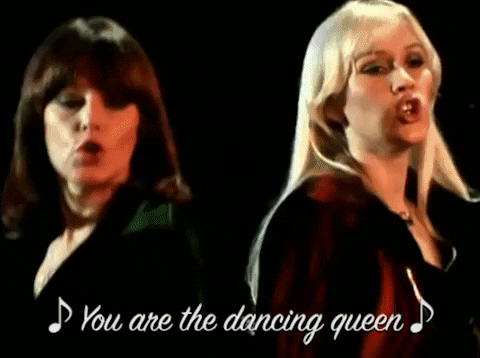
0 notes
Text
On this day in music history…man I do like that Acker Bilk song….
November 2nd
2021 - Declan Mulligan
Irish-born American rock musician, singer and songwriter Declan Mulligan died age 83. He was best known as a guitarist of rock band The Beau Brummels that formed in San Francisco in 1964 and broke into the mainstream with their debut single, ‘Laugh, Laugh'.
2018 - Chris Cornell
The widow of Soundgarden singer Chris Cornell was suing his doctor, accusing him of overprescribing drugs that ultimately led to his death in 2017. Vicki Cornell alleged that Dr Robert Koblin 'negligently and repeatedly' prescribed the singer 'dangerous mind-altering controlled substances'. Cornell was found in a Detroit hotel room and his death was ruled a suicide.
2014 - Acker Bilk…attention Keith
Acker Bilk, the clarinet player passed away at the age of 85. Bilk's 1962 instrumental tune 'Stranger on the Shore' became the UK's biggest selling single of 1962: it was in the UK charts for more than 50 weeks, peaked at No.2, and was the first No.1 single in the United States by a British artist in the era of the modern Billboard Hot 100 pop chart.
2007 - Led Zeppelin
Led Zeppelin's eagerly-awaited reunion concert in London was postponed for two weeks after guitarist Jimmy Page broke a finger. The tribute concert in honour of late Atlantic Records founder Ahmet Ertegun scheduled for 26 November would now take place on 10 December. More than a million fans applied for the 20,000 tickets available, which cost £125 each. Profits from the show would go towards scholarships in Ertegun's name in the UK, USA and the country of his birth Turkey.
2007 - Ozzy Osbourne
Ozzy Osbourne claimed his reputation had been tarnished after a party supposedly involving him was organised by US police officers to round up missing criminal suspects. Over 500 people in North Dakota with outstanding arrest warrants were sent invitations and more than 30 suspects turned up. Osbourne said it was "insulting" that his name had been used but police argued it was a "creative" way to fight crime. Ozzy had been selected because he was due to play a gig in a nearby arena, which was used to explain why he would supposedly have attending the party.
1984 - Marvin Gaye
The Rev Marvin Gaye Sr. was sentenced to a suspended six-year sentence and probation for the manslaughter of his son, Marvin Gaye. He later died at a nursing home in 1998.
1979 - AC/DC
AC/DC played the second of three sold out nights at the Hammersmith Odeon, London, England, with Def Leppard supporting.
1978 - Police
The Police released their debut album, Outlandos d'Amour. The working title, 'Police Brutality,' was changed to make is sound more romantic. The title loosely translates as 'Outlaws of Love' but the term 'Outlandos' is actually a mix of the words for 'Outlaws' and 'Commandos.' Elevated by the success of its lead single, 'Roxanne', Outlandos d'Amour peaked at No. 6 on the UK Albums Chart and at No. 23 in the United States. The album spawned two additional hit singles: 'Can't Stand Losing You' and 'So Lonely'.
1974 - George Harrison
George Harrison became the first Beatle to undertake a solo world tour when he played the first show of a 30-night tour in Vancouver, Canada.
1969 - Archies
Sugar Sugar by The Archies was at No.1 on the UK singles chart. The single became the longest running One Hit Wonder in the UK with eight week's at the top of the charts.
1969 - Creedance Clearwater Revival
Creedence Clearwater Revival released Willy and the Poor Boys, the third studio album that the band released in this year. The album features the songs 'Down on the Corner', from which the album got its name, and 'Fortunate Son', which is a well known protest song and their version of the Lead Belly song 'Cotton Fields'.
1967 - Cream
Cream released their second studio album Disraeli Gears which became the group's American breakthrough, becoming a massive seller in 1968, and reaching No.4 on the American charts. The album features the two singles 'Strange Brew' and 'Sunshine of Your Love'.
1967 - The Beatles
The Beatles completed recording their next single ‘Hello Goodbye’ at Abbey Road studios London with a second Paul McCartney bass line. The McCartney song had been selected for the A-side for The Beatles next single, the flip side to be Lennon’s ‘I Am The Walrus’.
1963 - David Bowie
The Konrads, featuring David Bowie appeared at Shirley Parish Hall, Shirley, Croydon, England.
1958 - Tommy Edwards
Tommy Edwards was at No.1 on the UK singles chart with 'It's All In The Game.' Written by Charles Dawes, later Vice President of the United States under Calvin Coolidge. It is the only No.1 pop single to have been co-written by a US Vice President!
0 notes
Text
Paul and Linda, a collection of PDAs: Part 3 - Holding Hands & Linking Arms …
… and arms around shoulders, etc.
This was a first: a rock music marriage that was openly romantic and family oriented. So many photos of them close together and always touching that we just have to say, “Aww.”


Jan. 1969 From the documentary Get Back. An arm around the shoulder and some hand holding at the same time (multitasking 😊)
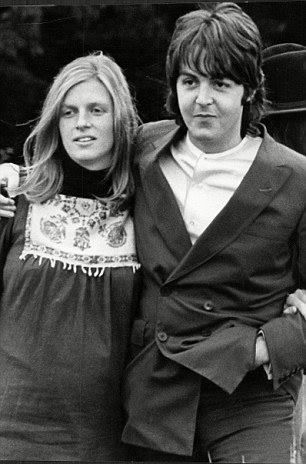
Aug. 22, 1969, six days before daughter Mary’s birth.

June 1971 Scotland. Still from the video for the song “Heart of The Country”


Nov. 8, 1971 Launch party for the band Wings and their debut album Wild Life at Empire Ballroom in West London.

July 16, 1972 A walk in Paris, France. Photo by Alain Dejean.

1973 Backstage during The James Paul McCartney TV special
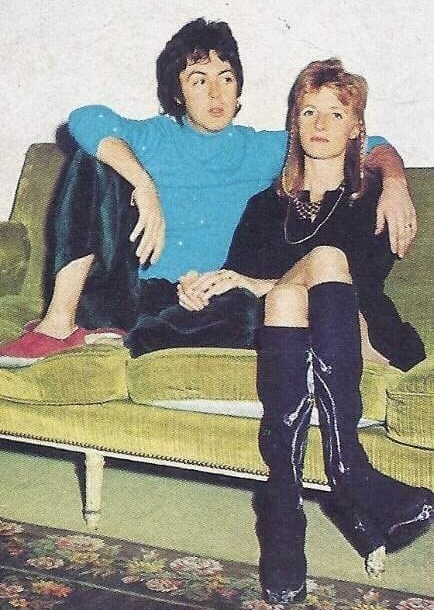
1973 An arm around Linda plus groovy footwear all in the same photo. 😎 🆒

April 1974 at Beverly Hills Hotel, where Paul and Linda stayed with their children while in L.A. to attend the Academy Awards.
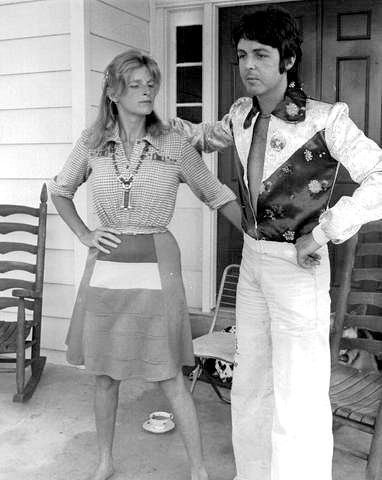
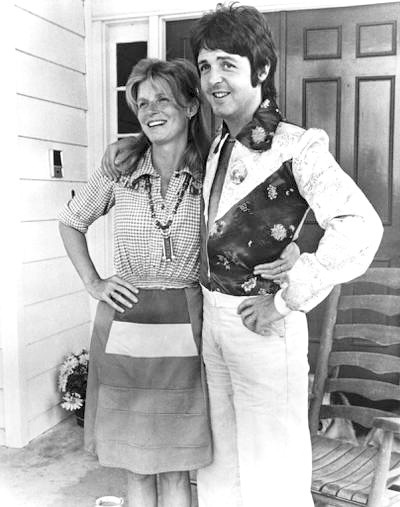
July 18, 1974 at Curly Putnam’s farm in Lebanon, Tennessee (near Nashville)

Also appears to be Nashville, June or July of 1974. Paul had that haircut while he was in Nashville, and Linda had worn that same halter top in other Nashville photos.

1975 Photo shoot for People magazine cover story April 21, 1975 issue. The article title was “The McCartneys Paul & Linda,” followed by a quote from Paul: “My family is my life, then my music.” Photo by Harry Benson.
Gotta love those special pics of Paul’s hand clasping Linda’s (or vice versa), with the wedding ring(s) clearly in view.
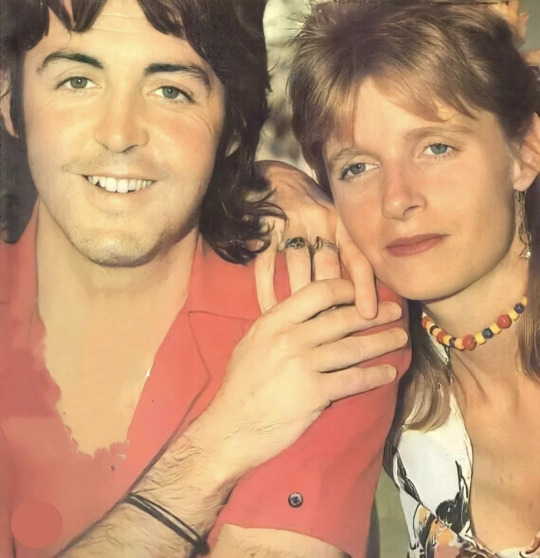
Nov. 1, 1975 Perth, Australia press conference. Another one of those lovely pics where Paul touches Linda’s hand, which happens to be touching him. 💞 💖
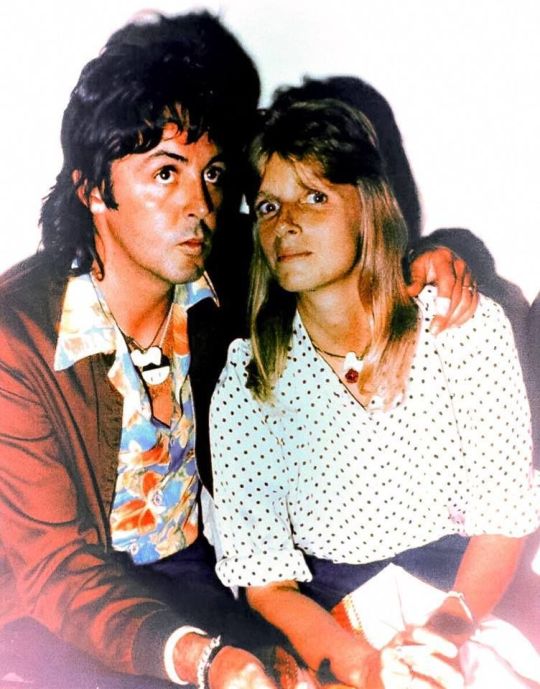
1976 during the Wings Over America Tour (May 3, 1976 to Oct. 21, 1976). This was the U.S. part of the Wings Over The World Tour (Sept. 9, 1975 to Oct. 21, 1976).

1976 Family vacation in Saint Tropez. Either Paul just woke up yawning after a nap, or he’s surprised to see a photographer nearby. Linda is looking sun-kissed with her arm draped over Paul’s shoulder. Photo by James Andanson/Sygma.
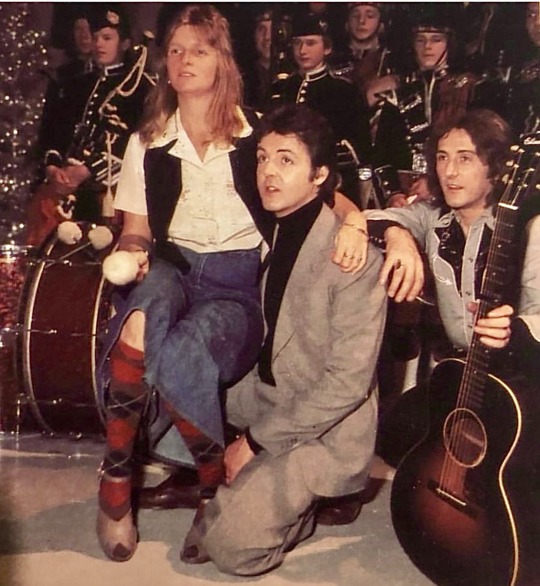
1977 With bagpipe band for appearance on Mike Yarwood Christmas Show to perform the Wings single “Mull of Kintyre.” A shortage of chairs, so Paul gives Linda his knee to sit on. What a gentleman. 🌹💐

Late 1970s. Hmm, are his eyes on their guest, or on something else? 😉 😎

May 14, 1980 Cannes, France for Cannes Film Festival, where Linda and director Oscar Grillo won the Palme D’Or for best short film, Seaside Woman, a 5-minute animation based on the first song Linda wrote in 1973.
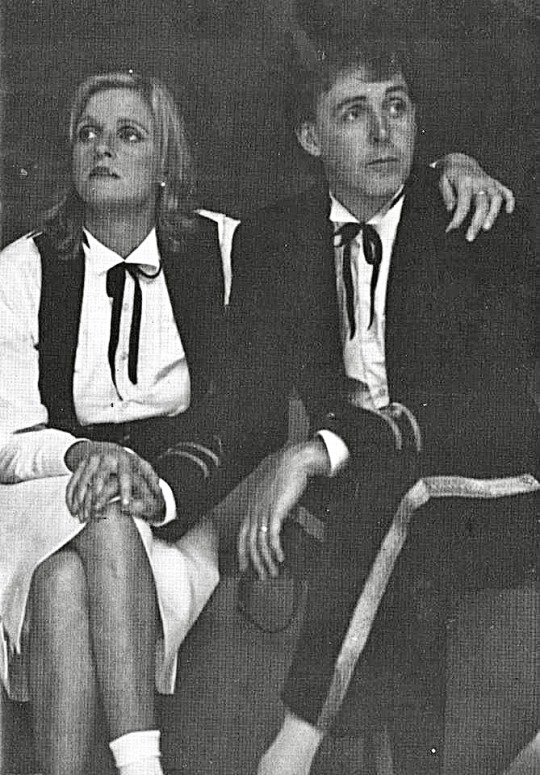
June 23, 1982 During filming of music video for the song “Take It Away” on stage 4 at Elstree Studios in Hertfordshire, U.K.

1982 Having fun filming for the “Tug of War” music video. Don’t let go of that hand Paul!
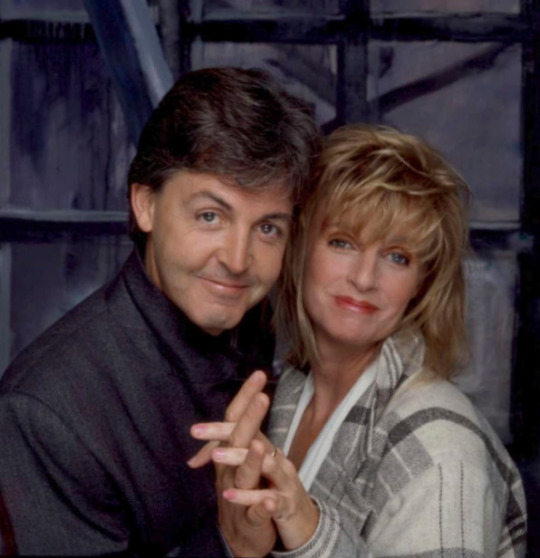
1984 🎵 I wanna hold your hand. 🎶 Photo by Terry O’Neill



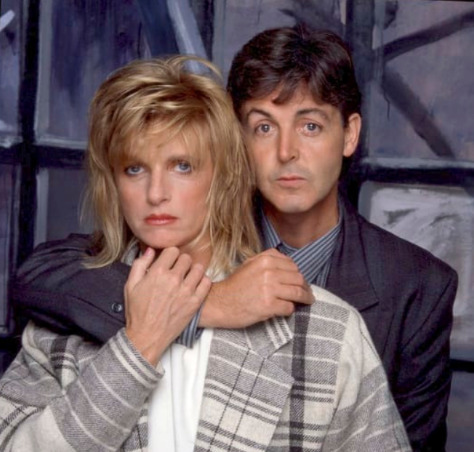
1984 🎶 I still wanna hold your hand … close to my heart (aww), ❤️ but sometimes I just want to hold your wrist. 😍 Photos by Terry O’Neill.
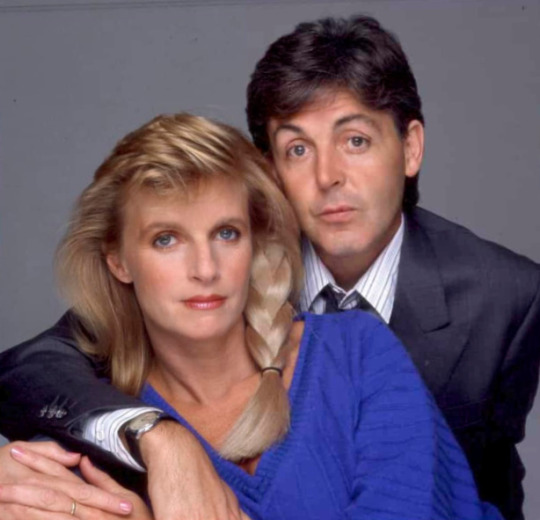
c. 1985 Photo by Terry O’Neill

1990 Photo by Bill Bernstein.
#paul mccartney#linda mccartney#paul and linda mccartney#paul and linda#paul and linda romantic#paul and linda forever#linda and paul#linda eastman mccartney#linda louise mccartney#linda mccartney and wings#lovely linda
3 notes
·
View notes
Text
Bram Stoker's Dracula Limited Edition 30th Anniversary Steelbook Review
This 4K version of 1992's Bram Stoker's Dracula is well worth buying when it's out on October 4, 2022. Even if you've seen it, you've never seen it like this.

SYNOPSIS
From Academy Award®-winning director Francis Ford Coppola (1974 Best Director, The Godfather: Part II) comes the classic and chilling tale about the devastatingly seductive Transylvanian prince (Gary Oldman) who travels from Eastern Europe to 19th-century London in search of human love. When the charismatic Dracula meets Mina (Winona Ryder), a young woman who appears as the reincarnation of his lost love, the two embark on a journey of romantic passion and horror.
DISC DETAILS & BONUS MATERIALS
4K ULTRA HD DISC
Dolby Atmos audio + 5.1 + Dolby Stereo
Special Features:
NEWLY ADDED: “Love Song For A Vampire” Music Video by Annie Lennox
NEWLY ADDED: Blood Lines – Dracula: The Man, The Myth, The Movies Featurette
BLU-RAY DISC™
Feature presented in High Definition, sourced from the 4K master
Dolby Atmos audio
Special Features:
Audio Commentary featuring Director Francis Ford Coppola
Audio Commentary featuring Director Francis Ford Coppola, Visual Effects Director Roman Coppola and Makeup Supervisor Greg Cannom
Introduction by Francis Ford Coppola
Reflections in Blood: Francis Ford Coppola and Bram Stoker's Dracula
Practical Magicians: A Collaboration Between Father and Son
The Blood Is the Life: The Making of Bram Stoker's Dracula
The Costumes Are the Sets: The Design of Eiko Ishioka
In Camera: Naïve Visual Effects
Method and Madness: Visualizing Dracula
Deleted & Extended Scenes
Theatrical Teaser & Trailer
Buy it on Amazon now
0 notes
Text
Lyrics Gore Rang Pe Na Itna Gumaan Kar
Lyrics Gore Rang Pe Na Itna Gumaan Kar
Here is the Lyrics Gore Rang Pe Na Itna Gumaan Kar. The song is from the film Roti. Movie Roti was released in the year 1974.
Lyrics for “Gore Rang Pe Na Itna Gumaan Kar” are available in Bilingual i.e. Hindi and English. The song “Gore Rang Pe Na Itna Gumaan Kar” features superstar Rajesh Khanna and Mumtaz.
Kishore Kumar and Lata Mangeshkar have sung this beautiful song “Gore Rang Pe Na Itna…

View On WordPress
#All Time Best Duet Songs of Kishore Kumar#All Time Best Romantic Songs of Kishore Kumar and Lata Mangeshkar#All Time Best Songs of Mumtaz#Anand Bakshi Hits#Antakshari Songs from G#Best Bollywood Romantic Songs of 70s#Best Duet Songs of Kishore Kumar and Lata Mangeshkar#Best Duet Songs of Lata Mangeshkar#Best of Anand Bakshi and Kishore Kumar#Best of Anand Bakshi and Lata Mangeshkar Songs#Best of Anand Bakshi Kishore Kumar and Laxmikant-Pyarelal#Best of Anand Bakshi Kishore Kumar Lata Mangeshkar and Laxmikant Pyarelal#Best of Lata Mangeshkar and Laxmikant-Pyarelal#Best of Laxmikant-Pyarelal and Kishore Kumar#Best of Rajesh Khanna and Mumtaz#Best Romantic Songs of 1974#Best Romantic Songs of 70s#Best Romantic Songs of Mumtaz#Best Romantic Songs of Rajesh Khanna#Best Songs of Anand Bakshi#Best Songs of Laxmikant-Pyarelal and Anand Bakshi#Best Songs of Mumtaz#Best Songs of Rajesh Khanna and Kishore Kumar#Bollywood Retro Songs with 50 Million Views#Bollywood Songs of 1974#Hindi Song Lyrics Starting from G#Hindi Songs of 1974#Hindi Songs with 50 Million views#Lata Mangeshkar Songs#Lyrics Starting from G
0 notes
Video
youtube
"Waterloo" is a 1974 song from Swedish pop group ABBA's second album, Waterloo, and was the first single to be credited to them performing under the name ABBA. The title and lyrics reference the Battle of Waterloo, and use it as a metaphor for a romantic relationship.
The song was also the winning entry for Sweden in the 1974 Eurovision Song Contest. The victory began ABBA's path to worldwide fame. The Swedish version of the single was a double A-side with "Honey, Honey" on the flip, while the English version usually featured "Watch Out" on the B-side.
The single became a No. 1 hit in several countries. It reached #6 on the US Billboard Hot 100 in September 1974 and went on to sell nearly six million copies.
At the 50th anniversary celebration of the Eurovision Song Contest in 2005 it was chosen as the best song in the competition's history. It received the same honor in a 14-country open vote in the Eurovision Song Contest 2021 in Rotterdam, placing first.
#Waterloo#ABBA#1974#song#Eurovision#contest#Sweden#single#Benny Andersson#Agnetha Fältskog#Anni-Frid Lyngstad#Björn Ulvaeus
107 notes
·
View notes
Video
youtube
Kraftwerk are best known for being innovative pioneers in the field of electronic music, but by 1981, the rest of the world was finally catching up to them. Faced with living in the future they’d helped create, they released their last truly great album, Computer World, as a sort of reaction to the times. Find out more in my video, or by reading the transcript below the break.
Welcome to Passionate Reply, and welcome to Great Albums. Today, we’re talking about Kraftwerk, and what is perhaps their last truly “great” release: 1981’s Computer World.
Kraftwerk were, of course, one of the first groups to popularize the creation of music through chiefly electronic means. From their icy and robotic onstage demeanour to their stiff-shirted sense of style, just one look at them makes it clear the outsized influence that Kraftwerk have had on the genre we now think of as “electronic music.” While, at times, their significance can be over-emphasized, and I’ve always been critical of the way that the discourse on this all-male quartet has often squeezed out even earlier electronic pioneers like Wendy Carlos and Delia Derbyshire, it isn’t all for no reason. While Kraftwerk’s actual music often comes across as more accessible than experimental, the fact that they were doing it in the 1970s, long before synthesisers became a commonplace sight in popular music, should fill anyone with the sense that they were architects of the future.
Music: “The Model”
While “The Model” first debuted on Kraftwerk’s 1978 LP The Man-Machine, it was re-released as a single in 1981, where it saw substantial success in the charts. In those few short years, the musical landscape had changed, with younger artists like Gary Numan and OMD making headway in the charts with similarly synthesiser-centered songwriting. For almost the entirety of the 1970s, Kraftwerk had been contentedly putting along, secure in the knowledge that they represented the future of music. But now, as the 80s began, they were finally living in the world that they had made possible. The future had arrived for them--so what were they possibly going to do now? I think the best way to frame Computer World, and perhaps what makes it such an interesting album for me, is that it represents a reaction to the ways that the landscape of electronic music had shifted around the artists in these intervening years. On Computer World, Kraftwerk would both reflect as well as critique what younger artists inspired by them had started doing. It’s the first Kraftwerk album that seems to represent a true challenge being posed to these by now august and illustrious pioneers, forcing them to respond in new ways.
Music: “Pocket Calculator”
In many ways, “The Model” is a pop song--compared to most previous Kraftwerk compositions, it’s heavy on lyrics, and focused, surprisingly, on a human being, and a love story involving her. But I think the Computer World single “Pocket Calculator” is almost as good of a pop song as “The Model” is. Highly melodic, and almost candy-coated in its simpering exuberance, it has perhaps the hookiest hook anywhere in the Kraftwerk discography. I’m tempted to compare it to similarly bright and upbeat tracks from Yellow Magic Orchestra, such as “Ongaku”--particularly since it was also released in a Japanese-language version, as “Dentaku,” for that market. Still, there’s no avoiding that the subject matter of “Pocket Calculator” has taken a sharp turn back towards an iconically Kraftwerk subject matter: the inner life of the titular machine. While the narrator of the lyrics announces themself as “the operator” with the titular calculator, it’s also possible to interpret the lyrics as the voice of the machine itself. “I am adding and subtracting, I’m controlling and composing”--but who, indeed, is really performing these tasks: the operator, or the calculator itself? Perhaps a stronger example of Kraftwerk gone pop is “Computer Love.”
Music: “Computer Love”
Melodic, but also balladlike, “Computer Love” is an unambiguous return to the traditional pop theme of romantic love, absent from the asexual and perhaps childlike glee of “Pocket Calculator.” Its more plaintive hook is also an easy one to appreciate, and its theme is perhaps more universal: while listeners at the time may not have necessarily owned rapidly miniaturizing digital technology, surely, all of us have, at some point, felt lonely. “Computer Love” doesn’t just connect to that feeling, but it also offers us hope, in the form of an almost magical, futuristic solution for finding love. I think it’s the internal balance of “Computer Love” that makes me find it so captivating: it’s a song about despair at being alone, perhaps even intensified by the alienation of modern society in particular, but it’s also suffused with the romantic dream of computerized matchmaking services, which might, like so many other technological developments, tremendously improve one’s day-to-day life. In “Computer Love,” the machine is only a tool, a small piece of the overall human picture, and not the chief focus of the work--much as the camera for which “The Model” was posing was little more than a prop in that love story. But despite this optimism about online matchmaking, other tracks on the album seem more skeptical about our computerized future, including the opener and title track.
Music: “Computer World”
While Kraftwerk are best remembered as utopian thinkers, many of their compositions hint at the potential downsides to technological advancements, albeit subtly. Much like *The Man-Machine* alluded to works like Fritz Lang’s Metropolis and Karel Čapek’s R.U.R., the title track of *Computer World* prominently notes organizations like Interpol and Scotland Yard among those who may benefit from computers, hinting at fears of oppressive techno-surveillance expressed by works like Philip K. Dick’s “The Minority Report.” With its slinking rhythm and overall ominous feel, this track implies that we should be apprehensive, without necessarily stating what to fear, and I think that’s part of why it’s remained resonant. In today’s world of deepfakes and location tracking, we’re constantly vigilant over the nameless potential dangers presented by the machines in our pockets and handbags, even when we couldn’t explicitly state what they are. Our increasing distance from the album, in both time and technological progress, may present an obstacle to appreciating it as art. While it’s easy for me to get into the mindset of computers as something newfangled and exciting, having grown up earlier in the personal computer age and able to recall the way they were advertised and talked about in the 90s and 00s, I do wonder how this album sounds to my younger peers. At any rate, “Numbers” is the track that I think sounds the most like it could have been on any Kraftwerk album, and not just this one.
Music: “Numbers”
A classic example of how a simple conceit can fill a whole composition to its brim, “Numbers” remains one of Kraftwerk’s most iconic tracks. Nowadays, it might be best known for how heavily it’s been sampled by later artists, and the influence it’s had on hip-hop, that nephew of electronic music that is nowadays, somewhat arbitrarily, considered a separate genre unto itself. But ultimately, “Numbers” and its famous beat stand up perfectly well on their own. As a cosmopolitan panoply of languages recites the names of the numbers, we are reminded of the ways in which mathematics is a universal language. Not only does it unite mankind, but many have also wondered if it might someday be the key to communicating with people from beyond the stars--an honour also bestowed upon music itself. Structurally, “Numbers” is the second-to-last song on the album’s first side, and like many earlier Kraftwerk albums, it transitions directly into another part of a larger “suite,” connected both musically and thematically. “Numbers” becomes “Computer World 2,” which is not simply a reprise of the title track, but a sort of medley which also incorporates the whispering vocoders of “Numbers.” While in many ways, Computer World feels like an attempt by Kraftwerk to keep up with the times, the overall structure of the album maintains a sense of continuous, symphonic composition, not unlike the seamless “transfer” between “Trans-Europe Express” and “Metal on Metal” some years before.
The cover design of Computer World is another in the long list of the aesthetic triumphs of Kraftwerk, which, I maintain, are perhaps as important and influential as their music itself. Its bright yellows and greens remain eye-catching, as does its portrayal of the band members’ portraits, rendered on a computer terminal. Despite seemingly now only existing in cyberspace, their faces remain in the position we saw them in on The Man-Machine, projecting their beatific gazes towards the leftward horizon of the future. The struggle between the reality of a human being, and that which is affected by their simulacrum, is a strong theme throughout Kraftwerk’s discography, stretching back, at least, to “Showroom Dummies,” and the cover of Computer World seems to take it another step further. Now, we don’t even contend with the idea of physical replicas of humanity, in the form of trudging robots or glib mannequins, but rather with the idea of an ethereal, holographic doppelgaenger. With its title, the album asks us not only to consider computers as technologies in and of themselves, but about an entire new era, and a new way of being, which is brought about by their arrival and proliferation. In many ways, this way of thinking about the future was more correct than perhaps anyone knew at the time, and I think it’s this sense of vision that makes Computer World remain a vital artwork as opposed to a curiosity.
As I said in the beginning, Computer World is often considered to be the last great album Kraftwerk made, putting an end to their streak of classics that began with 1974’s Autobahn. Their follow-up to it was the troubled and controversial Electric Cafe, released in 1986, which attempted, unsuccessfully, to add more dance influences and samples with the textures of more traditional instruments into their sound. While I think Electric Cafe is an album not without its merits, it is certainly a substantial departure from the Kraftwerk sound we’ve gotten familiar with so far. I might characterize it as an album that perhaps went too far into the territory of attempting to keep up with the times, extending Computer World’s lunge for more accessible, lyrical pop further than it could reach. Whatever the motivations, it’s hard to hear Electric Cafe tracks such as “Sex Object” without being at least a bit startled at the group’s willingness to tackle the topic of sex so frankly. It might be the only Kraftwerk song in which being like an object or a machine is portrayed in an unambiguously negative light.
Music: “Sex Object”
I think my favourite track on Computer World is its closing track, “It’s More Fun To Compute.” With a straightforward repetition of the title as its sole lyrical content, and a brazen, strident synth blast propelling it forward, it’s another one of those simple, but utterly compelling tracks that Kraftwerk seem to have been full of. Despite the way it flips into something much more melodic later on, it’s the tumult of the opening bars that really sells me on “It’s More Fun To Compute.” I think the textural qualities are almost a bit reminiscent of the grating oscillations of their often overlooked earlier album, Radio-Activity. That’s everything for today, thanks for listening!
Music: “It’s More Fun To Compute”
22 notes
·
View notes